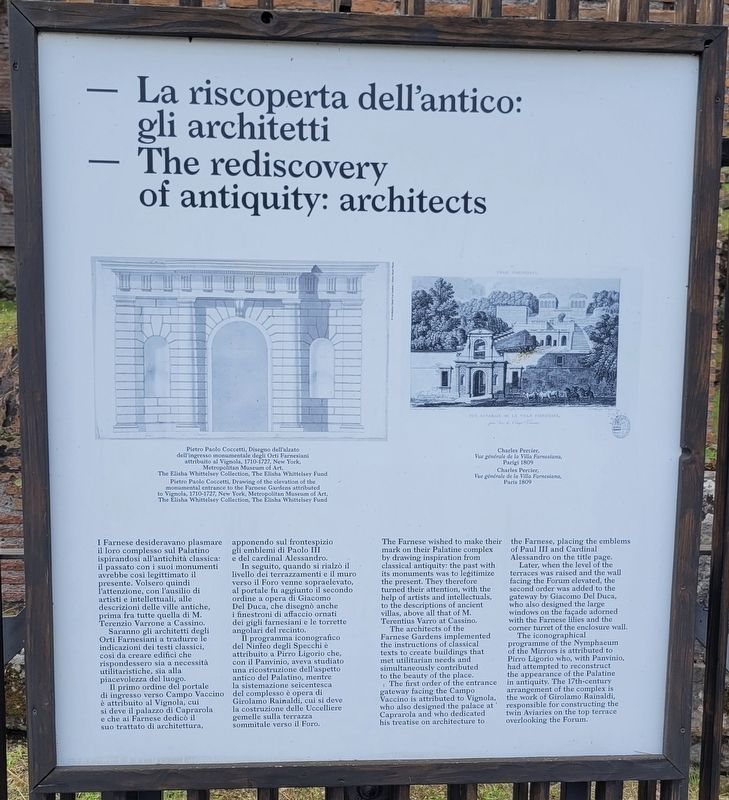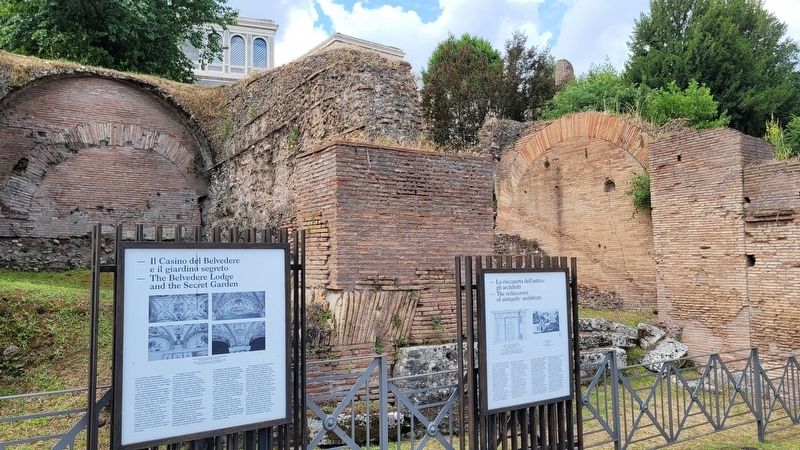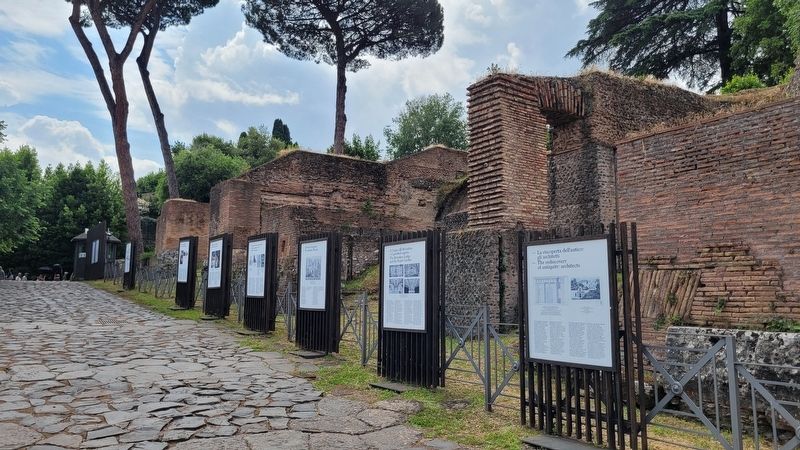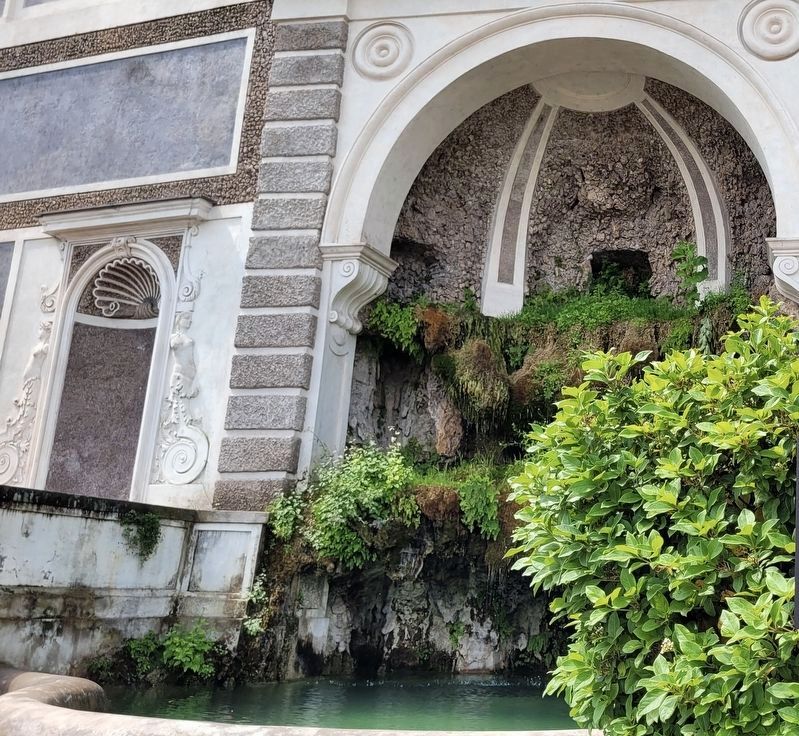Rione X Campitelli in Roma in Città metropolitana di Roma Capitale, Latium, Rome, Italy — Central Italy (Tyrrhenian Coast)
La riscoperta dell'antico: gli architetti / The rediscovery of antiquity: architects
Inscription.
Saranno gli architetti degli Orti Farnesiani a tradurre le indicazioni dei testi classici, così da creare edifici che rispondessero sia a necessità utilitaristiche, sia alla piacevolezza del luogo.
Il primo ordine del portale di ingresso verso Campo Vaccino è attribuito al Vignola, cui si deve il palazzo di Caprarola e che ai Farnese dedicò il suo trattato di architettura, apponendo sul frontespizio gli emblemi di Paolo III e del cardinal Alessandro.
In seguito, quando si rialzò il livello dei terrazzamenti e il muro verso il Foro venne sopraelevato, al portale fu aggiunto il secondo ordine a opera di Giacomo Del Duca, che disegnò anche i finestroni di affaccio ornati dei gigli farnesiani e le torrette angolari del recinto.
Il programma iconografico del Ninfeo degli Specchi è attribuito a Pirro Ligorio che, con il Panvinio, aveva studiato una ricostruzione dell'aspetto antico del Palatino, mentre la sistemazione seicentesca del complesso è opera di Girolamo Rainaldi, cui si deve la costruzione delle Uccelliere gemelle sulla terrazza sommitale verso il Foro.
Didascalie
Pietro Paolo Coccetti, Disegno dell'alzato dell'ingresso monumentale degli Orti Farnesiani attribuito al Vignola, 1710-1727, New York, Metropolitan Museum of Art, The Elisha Whittelsey Collection, The Elisha Whittelsey Fund
Charles Percier, Vue générale de la Villa Farnesiana, Parigi 1809
The Farnese wished to make their mark on their Palatine complex by drawing inspiration from classical antiquity: the past with its monuments was to legitimize the present. They therefore turned their attention, with the help of artists and intellectuals, to the descriptions of ancient villas, above all that of M. Terentius Varro at Cassino.
The architects of the Farnese Gardens implemented the instructions of classical texts to create buildings that met utilitarian needs and simultaneously contributed to the beauty of the place.
The first order of the entrance gateway facing the Campo Vaccino is attributed to Vignola, who also designed the palace at Caprarola and who dedicated
his treatise on architecture to the Farnese, placing the emblems of Paul III and Cardinal Alessandro on the title page.
Later, when the level of the terraces was raised and the wall facing the Forum elevated, the second order was added to the gateway by Giacomo Del Duca, who also designed the large windows on the façade adorned with the Farnese lilies and the corner turret of the enclosure wall.
The iconographical programme of the Nymphaeum of the Mirrors is attributed to Pirro Ligorio who, with Panvinio, had attempted to reconstruct the appearance of the Palatine in antiquity. The 17th-century arrangement of the complex is the work of Girolamo Rainaldi, responsible for constructing the twin Aviaries on the top terrace overlooking the Forum.
Captions
Pietro Paolo Coccetti, Drawing of the elevation of the monumental entrance to the Farnese Gardens attributed to Vignola, 1710-1727, New York, Metropolitan Museum of Art, The Elisha Whittelsey Collection, The Elisha Whittelsey Fund
Charles Percier, Vue générale de la Villa Farnesiana, Paris 1809
Topics. This historical marker is listed in these topic lists: Anthropology & Archaeology • Architecture • Horticulture & Forestry. A significant historical year for this entry is 1809.
Location. 41° 53.442′ N, 12° 29.266′
E. Marker is in Roma, Lazio (Latium, Rome), in Città metropolitana di Roma Capitale. It is in Rione X Campitelli. Marker is at the intersection of Via Nova and Via Sacra on Via Nova. The marker is located west of the Arch of Titus in the Roman Forum. Touch for map. Marker is in this post office area: Roma, Lazio 00186, Italy. Touch for directions.
Other nearby markers. At least 8 other markers are within walking distance of this marker. Il Casino del Belvedere e il giardino segreto / The Belvedere Lodge and the Secret Garden (here, next to this marker); Il Teatro di ingresso / The entrance Theatre (here, next to this marker); Il recinto con il suo portale / The boundary wall and its entrance (a few steps from this marker); La costruzione degli Orti: il giardino del Duca di Parma (a few steps from this marker); Ritratto di famiglia / Portrait of a family (a few steps from this marker); L'ascesa dei Farnese / The rise of the Farnese (a few steps from this marker); La costruzione degli Orti: uccelliere e catene d'acqua (a few steps from this marker); Buildings Opening Onto The Via Nova (a few steps from this marker). Touch for a list and map of all markers in Roma.
More about this marker. The marker is located in the Parco Archeologico del Colosseo (Roman Forum Archaeological Park) and it does require an entry fee to visit.
Also see . . .
1. Parco Archeologico del Colosseo. Roma Turismo (Submitted on August 16, 2023, by James Hulse of Medina, Texas.)
2. Farnese Gardens. Wikipedia (Submitted on August 16, 2023, by James Hulse of Medina, Texas.)
Credits. This page was last revised on August 16, 2023. It was originally submitted on August 16, 2023, by James Hulse of Medina, Texas. This page has been viewed 60 times since then and 13 times this year. Photos: 1, 2, 3, 4. submitted on August 16, 2023, by James Hulse of Medina, Texas.



